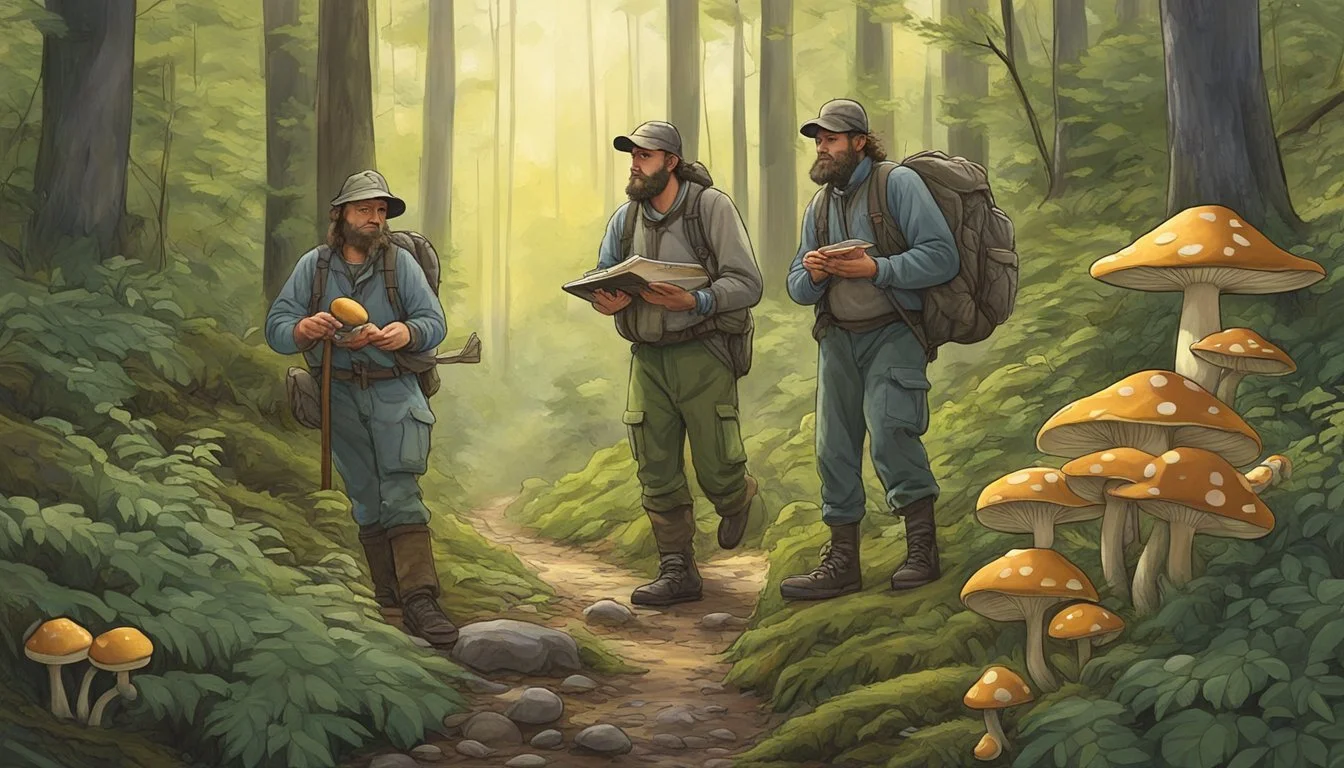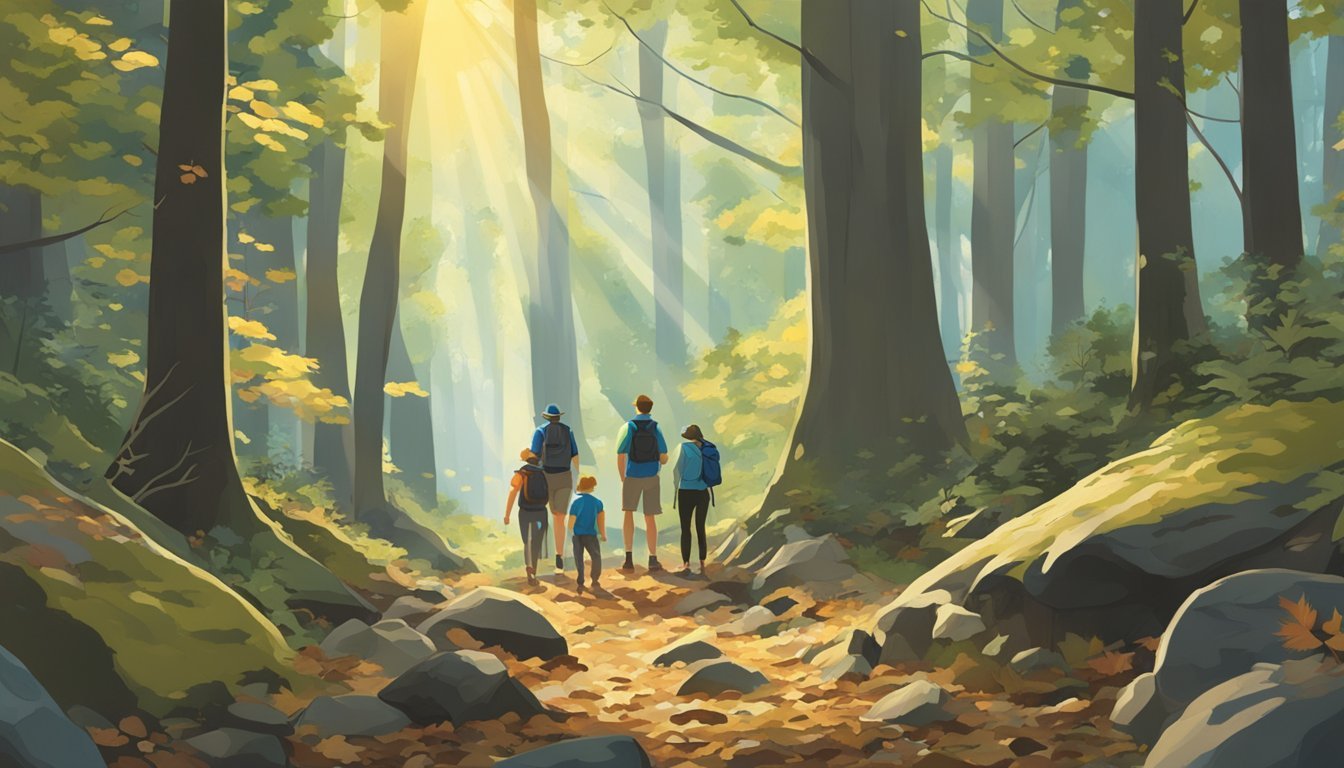Allegheny Plateau Mushroom Hunting
Tips and Best Practices
In the heart of Pennsylvania lies the Allegheny Plateau, a region renowned for its rich biodiversity and unspoiled natural beauty. This area offers a prime landscape for mushroom hunting, attracting both novice and seasoned foragers alike. The Allegheny Plateau’s diverse ecosystems make it an excellent destination for discovering a variety of fungi, from Morels to Boletus edulis and beyond.
Foraging through Pennsylvania's forests offers enthusiasts the chance to explore a range of mushroom species that thrive in different habitats. The region's damp soil, often found near Elm, Apple, Tulip Poplar, Ash, or Sycamore trees, provides the perfect conditions for mushroom growth, particularly in mid-April to mid-May.
Hunters in the Allegheny Plateau can look forward to not just finding mushrooms but also enjoying scenic hikes and the tranquil beauty of the Pennsylvania wilderness. Whether you're a local or a visitor, there's a wealth of natural treasures waiting to be uncovered.
Understanding the Allegheny Plateau
The Allegheny Plateau, spanning portions of New York, Pennsylvania, Ohio, New Jersey, and West Virginia, is known for its rugged terrain and diverse ecosystems. This area is rich in biodiversity, harboring numerous plant and animal species within its forests and natural landscapes.
Geography and Topography
The Allegheny Plateau is a dissected plateau characterized by steep hills and deep valleys. It covers significant parts of the Appalachian range, with notable sections like the Allegheny National Forest. The plateau's topography includes rolling hills, mountainous regions, and flat areas.
Elevations vary greatly, reaching up to 3,000 feet in places. The region's geological history has led to a variety of soil types that support diverse vegetation, making it a prime area for foraging.
Ecosystems and Biodiversity
The ecosystems of the Allegheny Plateau are varied, ranging from dense hardwood forests to open grasslands. Key habitats include the Allegheny Front and Allegheny National Forest, which are crucial for preserving regional biodiversity. The area supports numerous wildlife species, including deer, black bears, and a variety of bird species.
Vegetation is equally diverse, with the presence of broadleaf and coniferous trees providing different microhabitats. The biodiversity stems from the plateau's varied topography and climate, which create many niches for different species. This rich ecosystem makes it an ideal location for activities like mushroom hunting, which requires keen knowledge of the natural environment.
Mushrooms of the Allegheny Plateau
The Allegheny Plateau is rich in diverse fungal species, providing ample opportunities for mushroom enthusiasts. This area offers unique growth conditions and habitats, making it a prime location for mushroom hunting. Protecting and conserving the natural environment is crucial for maintaining this biodiversity.
Common Species and Identification
The Allegheny Plateau hosts a variety of edible mushrooms, including Morel Mushrooms (Morchella esculenta), Chicken of the Woods (Laetiporus sulphureus), and Boletus edulis. Morels are easily spotted due to their honeycomb-like appearance.
Chicken of the Woods is recognizable by its vivid orange and yellow colors, growing on trees, especially oak. Another common species is the Pleurotus ostreatus, or Oyster Mushroom, which grows on dead or decaying wood.
Cantharellus sp. (Chanterelles) can also be found and are identified by their trumpet-like shape and golden hue. However, caution is advised as toxic mushrooms, such as the Amanita species, also inhabit the area.
Growth Conditions and Habitats
Mushrooms in the Allegheny Plateau thrive in mesic conditions, with moist, shaded environments being ideal. Forests dominated by oak and other hardwood trees provide a fertile ground for mushroom growth. Mushrooms like Morels and Boletus prefer the rich, loamy soils found in these woodlands.
Aspect and elevation also play crucial roles in mushroom distribution. For instance, north-facing slopes with dense canopy cover retain more moisture, making them optimal for species such as Chicken of the Woods. Fallen logs, decaying stumps, and undisturbed leaf litter create perfect microhabitats for various fungi.
Human activity and seasonal changes also affect mushroom availability. Regular rains in spring and fall boost fungal growth, while the summer can sometimes see a decline due to drier conditions.
Conservation and Protection
Conservation efforts are essential to protect the natural habitats within the Allegheny Plateau. Organizations like the Nature Conservancy work towards maintaining these ecosystems, ensuring sustainable mushroom foraging practices.
Foragers should be mindful of the impact of their activities on the environment. This includes avoiding overharvesting and damaging the sensitive mycelial networks. Awareness and respect for local wildlife, such as the Timber Rattlesnake, Bobcat, and Black Bear, are also crucial.
By following guidelines and regulations set by conservation bodies, foragers can help preserve the rich biodiversity of the Allegheny Plateau's fungal communities for future generations.
Foraging Techniques and Best Practices
Mushroom hunting on the Allegheny Plateau requires skill, careful preparation, and an understanding of sustainable foraging.
Preparation and Equipment
Proper preparation is key to a successful foraging trip. A basket or mesh bag allows for the dispersal of spores while carrying mushrooms. A knife is essential for cleanly cutting stems, and a brush helps clean dirt from the harvest. Field guides are invaluable for identifying species and ensuring safety. Maps also aid in locating specific habitats of fungi like Morel Mushrooms and Hericium Coralloides.
Identifying Edible versus Hazardous Fungi
Accurate identification is critical to prevent the consumption of toxic mushrooms. Field guides with clear images and descriptions aid in differentiating between edible mushrooms like Chanterelle and hazardous ones. Foraging mushrooms requires attention to details like cap color, gill structure, and spore prints. If in doubt, foragers should always consult an expert or refrain from consuming any uncertain finds.
Sustainable Foraging
Practicing sustainable foraging ensures the health of local ecosystems. Foragers should avoid over-picking and always seek permission when on private lands. Rotating foraging locations helps reduce the impact on any single area. By focusing on conservation, mushroom hunters preserve the land's productivity, ensuring future generations can also enjoy edible wild plants and fungi. Responsible foraging practices include leaving a portion of the mushrooms to allow for natural reproduction and maintaining the habitat's integrity.
Legal Considerations and Ethics
When mushroom hunting on the Allegheny Plateau, it's important to be aware of both the legal requirements and the ethical guidelines that ensure sustainable and responsible foraging. This involves understanding the regulations and permits needed, as well as practicing responsible hunting to minimize environmental impact.
Regulations and Permits
Hunting mushrooms in Allegheny Plateau's public lands often requires specific permits. In some areas, permits can cost $8 per day with a 3-day minimum. Hunters should check with local authorities to determine if special permissions or annual approvals are necessary for foraging in state parks or nature reserves.
Private property regulations also necessitate obtaining written permission from landowners. Collecting mushrooms without consent can result in trespassing charges. Always verify the latest rules and regulations for each specific territory, as they can vary.
Key points to consider:
Obtain required permits or permissions.
Verify state park and nature reserve rules.
Always have written consent for foraging on private properties.
Responsible Hunting and Environmental Impact
Ethical foraging on the Allegheny Plateau ensures both the health of the ecosystem and the safety of future mushroom populations. Collect no more than two-thirds of the mushrooms in any given area to allow the remaining fungi to spore and proliferate. Avoid areas designated as Late Successional Reserves where collecting is prohibited.
While foraging, avoid disturbing soil, plants, or wildlife habitats. Stick to established trails whenever possible to reduce environmental damage. Remember that some species, such as matsutake or truffles, may have additional restrictions to ensure their conservation.
Best practices for responsible hunting:
Harvest sustainably by leaving one-third of mushrooms.
Respect habitats and avoid off-trail damage.
Follow specific conservation rules for particular species and areas.
By following these legal and ethical guidelines, mushroom hunters can contribute positively to the conservation and protection of the delicate ecosystems on the Allegheny Plateau.
Recreational Activities in Allegheny Plateau
The Allegheny Plateau offers a diverse range of recreational activities, fostering a deep connection with nature. Visitors can enjoy hiking and camping, wildlife observation and photography, as well as fishing and other outdoor pursuits.
Hiking and Camping
The Allegheny Plateau boasts numerous hiking trails winding through dense forests and scenic landscapes. Trails vary in difficulty, catering to both novice and seasoned hikers. Popular trails traverse through Mountain Laurel thickets and offer stunning views of the plateau.
Camping options abound, from developed campgrounds to backcountry sites. Campers often encounter black bear, bobcat, and a variety of birds, making the experience memorable. The Mountain Laurel blooms in early June, adding to the enchanting ambiance.
Wildlife Observation and Photography
Wildlife enthusiasts and photographers find the Allegheny Plateau a paradise. The area supports a variety of species, including golden eagle, ruffed grouse, and black bear. Observation points and quiet areas are scattered throughout the plateau, ideal for sighting these creatures.
Spring and fall are particularly fruitful times for wildlife photography. Berries, nuts, and other natural foods attract animals, offering prime opportunities for capturing unique moments. Bobcats and various bird species are often seen along the streams and dense forest areas.
Fishing and Other Outdoor Pursuits
Fishing in the Allegheny Plateau is a favored activity, especially in the mountain streams that crisscross the landscape. Anglers can expect to catch trout and other freshwater species. Equipment rental and guided trips are available for those new to the sport.
Other outdoor activities include boating, horseback riding, and mushroom foraging. The rich soil and humid climate make the plateau an excellent spot for finding mushrooms, adding another layer of adventure. Picking roots, nuts, and berries can also be rewarding for foragers exploring the woods.






